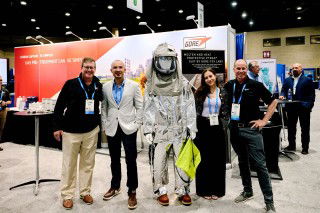FICEM, the Interamerican Cement Federation, staged the 32nd Technical Congress at the Hotel Royal Pedregal in Mexico City on 31 August to 2 September, 2015. Co-hosted by the Mexican Cement Association, CANACEM, the conference and exhibition was one of the largest ever gathered, with some 390 participants from the Latin American and the Caribbean cement sectors taking part. Over the course of the four-day event delegates attended technical presentations, explored the large equipment exhibition and toured Cementos Moctezuma’s Tepetzingo cement plant.
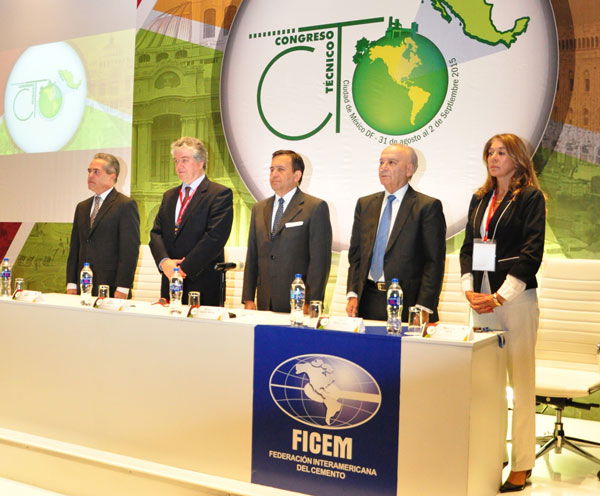
FICEM Opening Session – all stand for the national anthem of Mexico: Osmin Rendón, Executive President
of CANACEM (Mexico), Gabriel Restrepo, President of FICEM (Colombia), Ildefonso Guajardo Villarreal,
Secretary of Economy (Mexico), Guillermo Álvarez Cuevas, President of CANACEM (Mexico)
and María José Garcia, Director General of FICEM
The XXXII Technical Congress FICEM was formally opened by Ildefonso Guajardo Villarreal, Secretary of Economy (Mexico), who welcomed delegates and spoke optimistically about the economic reforms of President Enrique Peña Nieto. These reforms, he argued, are successfully improving the business environment for the entire domestic industry through reductions in energy costs, making it more competitive. Regarding the Mexican cement sector, Mr Villarreal highlighted its crucial role in the national development of Mexico and the importance of placing sustainability at the heart of the industry.
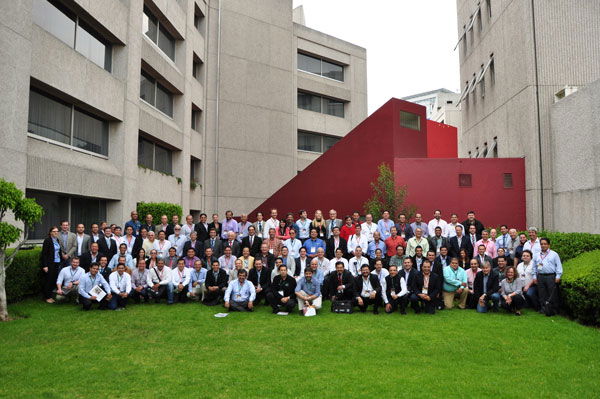 |
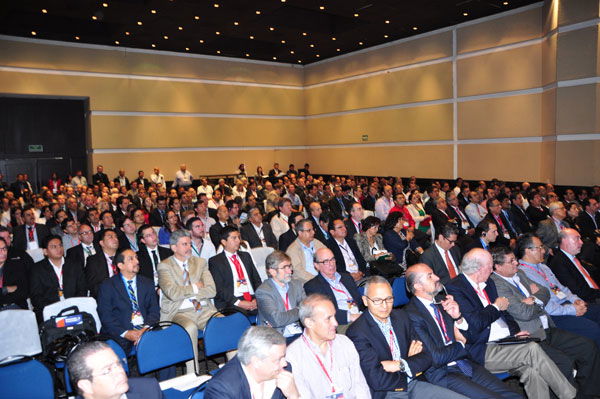 |
| FICEM’s 32nd Technical Congress was attended by nearly 400 delegates from Latin America | |
Taking this theme further, Gabriel Restrepo, President of FICEM (Colombia), spoke about climate change as the major challenge facing the regional, and indeed, global cement industry. The upcoming COP 21 climate talks in Paris in December will see most countries subscribe to new long-term CO2 emission targets in an attempt to limit global warming to below 2˚C, with material implications for the cement sector.
With sustainability, therefore, a key topic of the conference agenda, many of the 39 presentations were focussed on the technical innovations leading to sustainable cement production and featuring recent case studies illustrating successful examples of best practice in manufacturing technology.
Programme highlights

ICR’s Managing Editor, Thomas Armstrong, meeting Ildefonso
Guajardo Villarreal, Secretary of Economy (Mexico) –
now a keen reader of the industry’s leading cement publication
Elena Castellon of Cementos Argos (Colombia), winner of the best paper award, presented a framework for community engagement in the context of risk mitigation for large capital projects. “If collaboration with the community is inclusive, accountable and transparent,” she argued, “it is more likely to give optimum results for communities and project proponents.”
Other highly commended presentations were provided by Víctor Roldán and Francisco Castañeda from Cementos Progreso (Guatemala) on initiatives to reduce occupational noise emissions at the company’s San Miguel plant. Sophisticated noise mapping and soundproofing techniques were applied to reduce noise emissions to between 11 and 27db outdoors and 3.7db indoors.
Also commended was a presentation by Javier Pellegrini of Loma Negra (Argentina), in which he delivered a masterclass on the geological exploration of the Amalia limestone mine, covering all aspects of the reserve assessment from baseline geo-mining through raw material analysis to constructing a full geological model.

The 32nd Technical Congress concluded with a wonderful farewell
dinner full of lively entertainment programme in true Mexican style.
Other important contributions to the programme covered alternative fuels preparation (Wolfram Zschiesche, Vecoplan, Germany) and process optimisation for solid alternative fuels (Claudia Roxana, Universidad Nacional Autónoma de México). Grinding technologies also featured prominently, with presentations from KHD (Germany), Cemengal (Spain) and Christian Pfeiffer (Germany).
Away from production, Yassine Touahri of Exane BNP Paribas (UK) provided a detailed overview of global cement industry trends. He highlighted the export risk from China, which is now seeing consumption in decline, and weaknesses in key markets including Brazil, where a double-digit fall in demand is threatening utilisation rates.
Latin American growth in general is being undermined by depressed oil prices and weakening commodity exports to China, both of which are critical to the region’s growth. However, over the longer term the region has all fundamentals to achieve an attractive growth rate.
Outside of the conference hall, an international exhibition featuring 68 equipment suppliers from around the world offered cement producers the chance to meet technology suppliers and catch up with the latest product innovations on the market.
Plant tour
No technical conference is complete without a plant tour. This honour fell to Cemento Moctezuma, a subsidiary of Buzzi Unicem (Italy) and Cementos Molins (Spain), which opened the doors to its Tepetzingo facility in Morelos, around 100km south of Mexico City.
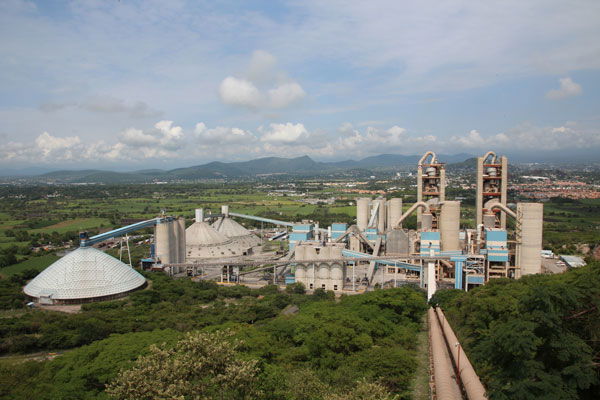
A field visit was held at Cemento Moctezuma’s 2.5Mta Tepetzingo plant
The plant commenced operations in 1997 and operates two kiln lines with a combined capacity of 2.5Mta. The works is distinctive in its use of Horomills for both raw material and finish grinding and produces a variety of CPC 30 and CPC40 blended cements, using pozzolan as the primary extender.
The annual FICEM event grows from strength to strength, reflecting the increasingly dynamic cement sector in the region and an appetite from cement producers to use this important forum to share knowledge and find solutions to the common challenges facing this industry.
